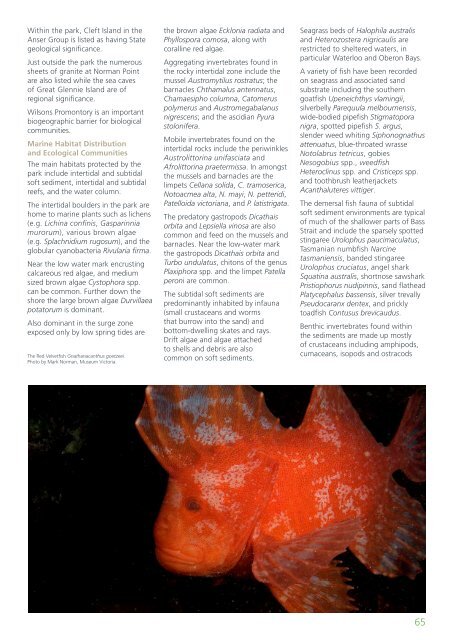Within the park, Cleft Island in theAnser Group is listed as having Stategeological significance.Just outside the park the numeroussheets of granite at Norman Pointare also listed while the sea cavesof Great Glennie Island are ofregional significance.Wilsons Promontory is an importantbiogeographic barrier for biologicalcommunities.<strong>Marine</strong> Habitat Distributionand Ecological CommunitiesThe main habitats protected by thepark include intertidal and subtidalsoft sediment, intertidal and subtidalreefs, and the water column.The intertidal boulders in the park arehome to marine plants such as lichens(e.g. Lichina confinis, Gasparinniamurorum), various brown algae(e.g. Splachnidium rugosum), and theglobular cyanobacteria Rivularia firma.Near the low water mark encrustingcalcareous red algae, and mediumsized brown algae Cystophora spp.can be common. Further down theshore the large brown algae Durvillaeapotatorum is dominant.Also dominant in the surge zoneexposed only by low spring tides areThe Red Velvetfish Gnathanacanthus goetzeei.Photo by Mark Norman, Museum <strong>Victoria</strong>.the brown algae Ecklonia radiata andPhyllospora comosa, along withcoralline red algae.Aggregating invertebrates found inthe rocky intertidal zone include themussel Austromytilus rostratus; thebarnacles Chthamalus antennatus,Chamaesipho columna, Catomeruspolymerus and Austromegabalanusnigrescens; and the ascidian Pyurastolonifera.Mobile invertebrates found on theintertidal rocks include the periwinklesAustrolittorina unifasciata andAfrolittorina praetermissa. In amongstthe mussels and barnacles are thelimpets Cellana solida, C. tramoserica,Notoacmea alta, N. mayi, N. petteridi,Patelloida victoriana, and P. latistrigata.The predatory gastropods Dicathaisorbita and Lepsiella vinosa are alsocommon and feed on the mussels andbarnacles. Near the low-water markthe gastropods Dicathais orbita andTurbo undulatus, chitons of the genusPlaxiphora spp. and the limpet Patellaperoni are common.The subtidal soft sediments arepredominantly inhabited by infauna(small crustaceans and wormsthat burrow into the sand) andbottom-dwelling skates and rays.Drift algae and algae attachedto shells and debris are alsocommon on soft sediments.Seagrass beds of Halophila australisand Heterozostera nigricaulis arerestricted to sheltered waters, inparticular Waterloo and Oberon Bays.A variety of fish have been recordedon seagrass and associated sandsubstrate including the southerngoatfish Upeneichthys vlamingii,silverbelly Parequula melbournensis,wide-bodied pipefish Stigmatoporanigra, spotted pipefish S. argus,slender weed whiting Siphonognathusattenuatus, blue-throated wrasseNotolabrus tetricus, gobiesNesogobius spp., weedfishHeteroclinus spp. and Cristiceps spp.and toothbrush leatherjacketsAcanthaluteres vittiger.The demersal fish fauna of subtidalsoft sediment environments are typicalof much of the shallower parts of BassStrait and include the sparsely spottedstingaree Urolophus paucimaculatus,Tasmanian numbfish Narcinetasmaniensis, banded stingareeUrolophus cruciatus, angel sharkSquatina australis, shortnose sawsharkPristiophorus nudipinnis, sand flatheadPlatycephalus bassensis, silver trevallyPseudocaranx dentex, and pricklytoadfish Contusus brevicaudus.Benthic invertebrates found withinthe sediments are made up mostlyof crustaceans including amphipods,cumaceans, isopods and ostracods65
and polychaetes.Subtidal reefs and the assemblagesassociated with them are stronglyinfluenced by the position of the reef,its orientation, slope, depth, exposureand topography. These physicalparameters influence key physicalprocesses such as light, water flowand sedimentation, and biologicalprocesses such as foraging andrecruitment.Shallow subtidal reefs are oftendominated by canopy forming algae.Deep reefs, where light penetrationis limited, may be dominated by largesessile invertebrates such as massivesponges, whip corals (Primnoellaaustralasia), soft corals andcolonial ascidians.Sessile invertebrates on moreshallow reefs include zoanthids(e.g. Parazoanthus sp.) andgorgonians (e.g. Pteronisis sp. andAcabaria sp.). Both canopy formingalgae and large sessile invertebratescan form habitat and food sourcesfor invertebrates and fish.The diversity and species compositionof subtidal reefs in the park varieswith location.Some of the common macrophytesinclude canopy forming brown algae(e.g. Phyllospora comosa, Eckloniaradiata and Seirococcus axillaris),understorey species (predominantlyred algae, e.g. Phacelocarpuspeperocarpus, Plocamium spp.,Pterocladia lucida, Ballia callitricha,Haliptilon roseum and MelanthaliaImage left:A common species in the park: butterfly perchCaesioperca lepidoptera.Image right:Hermit crab (probably Strigopagurus strigimanus).Photo by Julian Finn, Museum <strong>Victoria</strong>.obtusata), and mixed brown algae(e.g. Sargassum spp. Perithalia cordataand Acrocarpia paniculata).Mobile invertebrates found onsubtidal reefs in the park includesea urchins (e.g. Heliocidariserythrogramma), sea stars (e.g.Cenolia trichoptera, Nectria spp.and Plectaster decanus), molluscs(e.g. Haliotis rubra, Turbo undulatus),pycnogonids (e.g. Stylopallenedorsospinum and Acheliatransfugoides) and bryozoans(e.g. Canda arachnoides, Amathiaspp., Euthyroides episcopalis andTriphyllozoon munitum).The fish fauna includes wide-rangingcool temperate species endemicto Southern Australian, with a muchsmaller proportion of warmer-watertemperate species towards thesouthern limits of their range.Common species include old wivesEnoplosus armatus, the large bastardtrumpeter Latriopsis forsteri, variousperch Caesioperca spp., variouswrasse Notolabrus spp., southernhulafish Trachinops caudimaculatus,various sweep Scorpis spp., magpieperch Cheilodactylus nigripes,the toothbrush leatherjacketAcanthaluteres vittiger, herringcale Odax cyanomelas and madoAtypichthys strigatus.The water column is home to a varietyof planktonic and pelagic organisms.Those that make their permanenthome in the water column includesea jellies, salps, many fish, andphytoplankton and zooplankton.A number of marine mammals,turtles and seabirds are also foundin or use the water column.Species and Communitiesof Conservation SignificanceThe park has many species ofconservation significance includingtwenty five bird species (e.g. Latham’ssnipe Gallinago hardwickii, sanderlingCalidris alba, Caspian ternHydroprogne caspia and white-belliedsea-eagle Haliaeetus leucogaster),5 marine mammals (e.g. humpbackwhale Megaptera novaeangliae andthe killer whale Orcinus orca) and theleatherback turtle Dermochelyscoriacea on state, national orinternational conservation lists.The conservation listed green turtleChelonia mydas is a vagrant thathas also been recorded in or nearthe park.Seven species of fish found in thepark are also regarded as beingof conservation significance as theyare numerically and spatially rareat the state level (e.g. Sphyraenanovaehollandiae and Pentaceropsisrecurvirostris).The park is also a nationally significantarea for recovery of white sharkCarcharodon carcharias populations.It is home to one hundred and twentysix biota that have been recorded orpresumed to be at their distributionallimit including algae (e.g. Caulerpaspp. and Cystophora spp.), seagrass(Amphibolis antarctica), shrimp (e.g.Rhynchocinetes kuiteri), sea stars(e.g. Nectria multispina andEuantedon paucicirra), molluscs(e.g. Pisinna tumida tumida andNotoplax speciosa), sea urchins(e.g. Centrostephanus rodgersiiand Spatangus luetkeni), and fish(e.g. Dotalabrus aurantiacus andUpeneichthys vlamingii).66
















